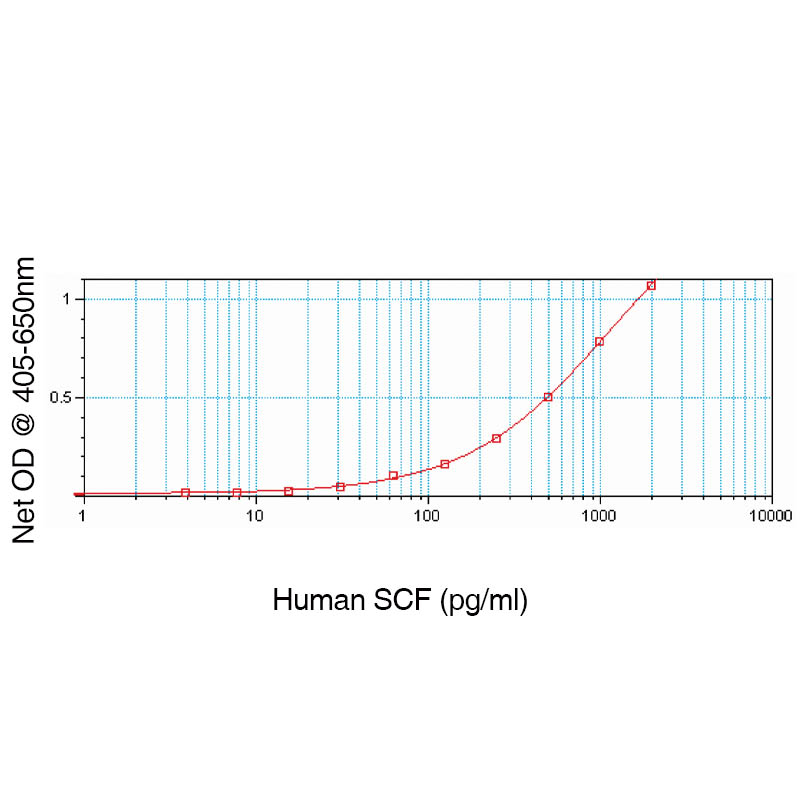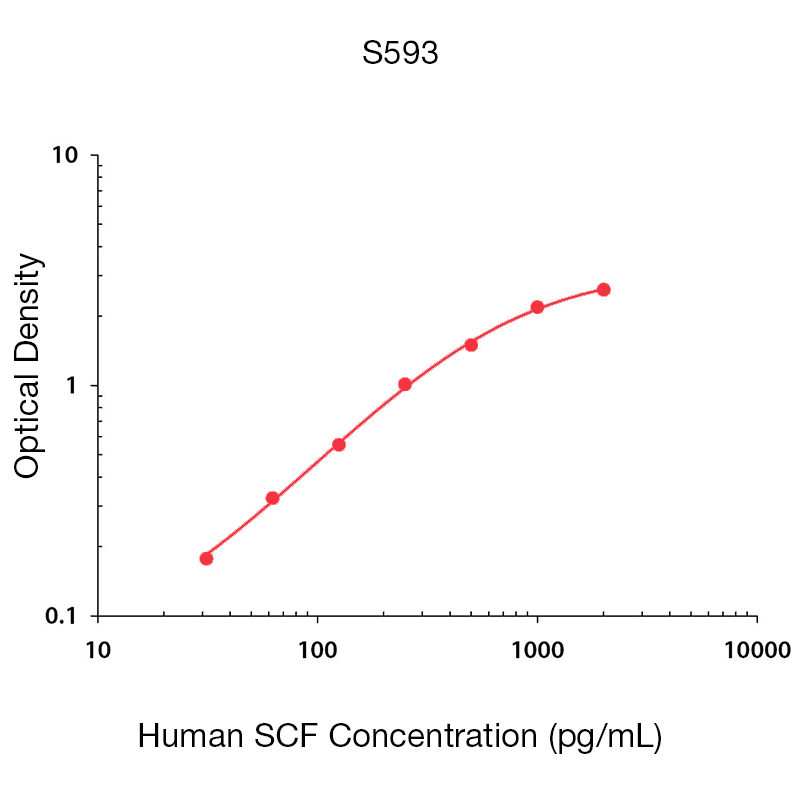Human SCF ELISA Development Kit
Data
- -
- -
Product DetailsDescription Human SCF ELISA Development Kit contains the key components required for the quantitative measurement of natural and/or recombinant SCF in a sandwich ELISA format. Using the ELISA protocol described below, this kit provides sufficient reagents to assay SCF in approximately 1500 ELISA plate wells. Materials Provided 1.) Capture Antibody 2.) Detection Antibody 3.) Standard 4.) StreptAvidin-HRP 5.) TMB Liquid Substrate "Ready to Use" Other Materials and Solutions Required Additional Required Materials ELISA microplates (Thermo Fisher Cat. # 456529) BSA (Sigma Cat. # A-7030) Dulbecco’s PBS (DPBS) [10x] (Leinco Product No. D388) Stop Solution: 450 nm Stop Reagent for TMB Microwell (Leinco Product No. T125) Required Solutions PBS: dilute 10xPBS to 1xPBS, pH 7.2, in sterile water Wash Buffer: 0.05% Tween-20 in PBS (Leinco Product No. W101) Reagent Diluent: 1.0% BSA in PBS* Blocking Buffer 1.0% BSA in PBS (Leinco Product No. B395) Note: Other acceptable blocking buffers such as Leinco's Ultra-FISH Block (Leinco Product No. B396) or Ultra-Sythetic Block (Leinco Product No. B397) may be used for assay optimization. Precautions Some of the required components may contain acid and/or cause allergic reactions. Breathing in product mist or fumes should be avoided. Wear protective gloves, clothing, eye, and face protection. Wash hands thoroughly after handling. Please refer to the MSDS on our website prior to use. Capture Antibody Mouse Anti-Human SCF Capture Antibody: Centrifuge vial prior to opening. Reconstitute in 1.0 mL sterile PBS. Refer to the lot-specific datasheet for amount supplied and dilute in PBS without carrier protein to the working concentration indicated on the C of A. Following reconstitution the capture antibody may be stored at 2 – 8°C for up to 6 months. For long term storage, it is recommended to aliquot into working volumes and store at -70°C in a manual defrost freezer. Avoid repeated freeze and thaw cycles. Biotin Detection Antibody Biotinylated Goat Anti-Human SCF Detection Antibody: Refer to the lot-specific datasheet for amount supplied. Centrifuge vial prior to opening. Reconstitute with 1.0 mL of Reagent Diluent. Dilute in Reagent Diluent to the working concentration indicated on the C of A. Detection antibodies may be stored at 2 – 8°C for up to 6 months. For long term storage, it is recommended to aliquot into working volumes and store at -70°C in a manual defrost the freezer. Avoid repeated freeze and thaw cycles. Recombinant Standards E. coli - expressed Recombinant Human SCF Standard: Centrifuge vial prior to opening. Reconstitute each vial with 0.5 mL of Reagent Diluent. Refer to the lot-specific datasheet for amount supplied. The rProtein may be stored at 2 – 8°C for one (1) month or aliquoted and stored at -70°C for up to three months in a manual defrost freezer. Avoid repeated freeze and thaw cycles. Substrate TMB Liquid Substrate "Ready to Use" (TMB Substrate should be at ambient temperature prior to use): 60.0 mL of TMB HRP Microwell Substrate Standard Kinetic One Component "Ready Use" (Leinco Product No. T118) is provided. The high quality of the substrate can be preserved by storing at temperatures between 2 – 8ºC. When properly stored, TMB Microwell Substrate is stable for a minimum of 48 months from the manufactured date. Plate Preparation 1. Dilute the capture antibody to the working concentration in PBS without carrier protein and immediately add 100 μL to each ELISA plate well. Seal the plate and incubate overnight at room temperature. 2. Aspirate the wells to remove liquid and wash the plate 4 times using 300-400 μL of wash buffer per well. Note: We recommend using an autowasher, although a squirt bottle or manifold dispenser would suffice. 3. After the last wash, invert plate to remove residual buffer and blot on paper towel. 4. Add 300 μL block buffer to each well and incubate for at least 1 hour at room temperature. 5. Aspirate and wash plate 4 times. NOTE: Complete removal of liquid at each step is essential for good performance and sensitivity of assay. Assay Procedure Standard/Sample: Add 100 μL of the working dilution with reagent dilution standard or sample to each well (duplicate recommended). Cover plate with an adhesive plate cover and incubate at room temperature for at least 2 hours. Detection: Aspirate and wash plate 4 times. Add 100 μL of the detection antibody, diluted in Reagent Diluent to each well. Cover with a new adhesive plate cover and incubate at room temperature for 2 hours. StreptAvidin-HRP Conjugate: Aspirate and wash plate 4 times. Add 100 μL of the working dilution (the dilution factor may require optimization) to each well. Cover and incubate at room temperature for 20-30 minutes. Exposure to direct light should be avoided. TMB Liquid Substrate: Aspirate and wash plate 4 times. Add 100 μL of TMB HRP Microwell Substrate Standard Kinetic One Component "Ready Use" (Leinco Product No. T118) to each well. Incubate at room temperature for 20-30 minutes and monitor color development. Exposure to direct light should be avoided. Stop Solution: Add 50-100 μL of Stop Solution (Leinco Product No. T125) to each well. Monitor color development with an ELISA plate reader at 450 nm with wavelength correction set at 540 nm or 570 nm. BackgroundStem cell factor (SCF), otherwise known as KIT ligand or Steel factor1 is a paracrine regulator of germ cell development.2 SCF has the ability to stimulate the growth of hematopoietic progenitor cells and to generate colony-forming cells (CFC) from highly enriched populations of hematopoietic cells.3 SCF is produced by the Sertoli cells and involved in the local regulation of spermatogenesis4 and liver regeneration.5 SCF in conjunction with interleukin-31 may play a significant role in airway remodeling by promoting the recruitment of bone marrow-derived fibroblast precursors into the lung with the capacity to promote lung myofibroblast differentiation.6 References & Citations1. Toppari, J. et al. (1999) Endocrin 140: 1492 2. Adamson, JW. et al. (1991) PNAS 88: 7420 3. Hervé, L. et al. (2005) J of Endocrin. 186: 131 4. Ramadori, G. et al. (2009) Lab Invest. 89(5):562-74. 6. Phan, SH. et al. (2009) AM J Pathol. 174: 390 |
Related Products
- -
- -
Prod No. | Description |
|---|---|
S498 | |
S500 | |
S593 |




